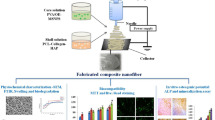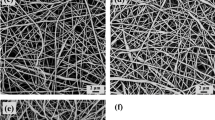Abstract
In this study, chitosan/hydroxyapatite (CS/HA) nanofibers were prepared using a wet chemical method. First, CS nanofibers with uniform diameters were fabricated using electrospinning. Then, a wet chemical process was used to mineralize nanofiber surfaces to form a homogeneous HA deposit. Reactions with three cycles were found to optimize biomimetic properties of the HA. The mineralization process required only approximately 3 h, which corresponded to a saving of 98 % in preparation time compared with that needed by the process using a simulated body fluid (SBF). According to the attachment and spreading of UMR (rat osteosarcoma) cells on the CS/HA composite fibers, the deposited mineralization layer significantly enhanced cell affinity of the CS nanofibers and the HA created by the wet chemical method was as effective as that created by the SBF. The composite nanofibrous scaffolds produced by the wet chemical process also promoted osteogenic differentiation by inducing ossification. Thus, expressions of collagen type I, alkaline phosphatase, osteocalcin, bone sialoprotein, and osterix were all enhanced. These results demonstrated that composite electrospun fibers can be efficiently prepared using wet chemical method and the resulting nanofibrous scaffolds have considerable potential in future bone tissue engineering applications.








Similar content being viewed by others
References
Constantz B, Ison I, Fulmer M, Poser R, Smith S, VanWagoner M, Ross J, Goldstein S, Jupiter J, Rosenthal D (1995) Skeletal repair by in situ formation of the mineral phase of bone. Science 267:1796–1799
Stevens MM, George JH (2005) Exploring and engineering the cell surface interface. Science 310:1135–1138
Bucholz RW, Carlton A, Holmes R (1989) Interporous hydroxyapatite as a bone graft substitute in tibial plateau fractures. Clin Orthop Relat Res 240:53–62
Kim HW, Song JH, Kim HE (2005) Nanofiber generation of gelatin-hydroxyapatite biomimetics for guided tissue regeneration. Adv Funct Mater 15:1988–1994
Zhang R, Ma PX (2004) Biomimetic polymer/apatite composite scaffolds for mineralized tissue engineering. Macromol Biosci 4:100–111
Cai X, Chen L, Jiang T, Shen X, Hu J, Tong H (2011) Facile synthesis of anisotropic porous chitosan/hydroxyapatite scaffolds for bone tissue engineering. J Mater Chem 21:12015–12025
Marra KG, Szem JW, Kumta PN, DiMilla PA, Weiss LE (1999) In vitro analysis of biodegradable polymer blend/hydroxyapatite composites for bone tissue engineering. J Biomed Mater Res 47:324–335
Venugopal J, Prabhakaran MP, Zhang Y, Low S, Choon AT, Ramakrishna S (2010) Biomimetic hydroxyapatite-containing composite nanofibrous substrates for bone tissue engineering. Philos Trans A Math Phys Eng Sci 368:2065–2081
Martins AM, Alves CM, Kasper FK, Mikos AG, Reis RL (2010) Responsive and in situ-forming chitosan scaffolds for bone tissue engineering applications: an overview of the last decade. J Mater Chem 20:1638–1645
Janes KA, Fresneau MP, Marazuela A, Fabra A, Alonso MJ (2001) Chitosan nanoparticles as delivery systems for doxorubicin. J Control Release 73:255–267
Sultana N, Khan TH (2013) Water absorption and diffusion characteristics of nanohydroxyapatite (nHA) and poly(hydroxybutyrate-co-hydroxyvalerate) based composite tissue engineering scaffolds and nonporous thin films. J Nanomater 2013:1–8
Yeong KCB, Wang J, Ng SC (2001) Mechanochemical synthesis of nanocrystalline hydroxyapatite from CaO and CaHPO4. Biomaterials 22:2705–2712
Rhee SH (2002) Synthesis of hydroxyapatite via mechanochemical treatment. Biomaterials 23:1147–1152
Madhumathi K, Shalumon KT, Rani VVD, Tamura H, Furuike T, Selvamurugan N, Nair SV, Jayakumar R (2009) Wet chemical synthesis of chitosan hydrogel–hydroxyapatite composite membranes for tissue engineering applications. Int J Biol Macromol 45:12–15
Kokubo T, Kushitani H, Ohtsuki C, Sakka S, Yamamuro T (1992) Chemical reaction of bioactive glass and glass-ceramics with a simulated body fluid. J Mater Sci Mater Med 1:79–83
Thien DVH, Hsiao SW, Ho MH, Li CH, Shih JL (2013) Electrospun chitosan/hydroxyapatite nanofibers for bone tissue engineering. J Mater Sci 48:1640–1645
Zhang Y, Zhang M (2001) Synthesis and characterization of macroporous chitosan/calcium phosphate composite scaffolds for tissue engineering. J Biomed Mater Res 55:304–312
Li Z, Ramay HR, Hauch KD, Xiao D, Zhang M (2005) Chitosan–alginate hybrid scaffolds for bone tissue engineering. Biomaterials 26:3919–3928
Min BM, Lee G, Kim SH, Nam YS, Lee TS, Park WH (2004) Electrospinning of silk fibroin nanofibers and its effect on the adhesion and spreading of normal human keratinocytes and fibroblasts in vitro. Biomaterials 25:1289–1297
Yoshimoto H, Shin YM, Terai H, Vacanti JP (2003) A biodegradable nanofiber scaffold by electrospinning and its potential for bone tissue engineering. Biomaterials 24:2077–2082
Akao M, Aoki H, Kato K (1981) Mechanical properties of sintered hydroxyapatite for prosthetic application. J Mater Sci 16:809–812
Kong LB, Ma J, Boey F (2002) Nanosized hydroxyapatite powders derived from coprecipitation process. J Mater Sci 37:1131–1134
Narasaraju TSB, Phebe DE (1996) Some physico-chemical aspects of hydroxylapatite. J Mater Sci 31:1–21
Madhumathi K, Binulal NS, Nagahama H, Tamura H, Shalumon KT, Selvamurugan N, Nair SV, Jayakumar R (2009) Preparation and characterization of novel β-chitin-hydroxyapatite composite membranes for tissue engineering applications. Int J Biol Macromol 44:1–5
Ngiam M, Liao S, Patil AJ, Cheng Z, Chan CK, Ramakrishna S (2009) The fabrication of nano-hydroxyapatite on PLGA and PLGA/collagen nanofibrous composite scaffolds and their effects in osteoblastic behavior for bone tissue engineering. Bone 45:4–16
Peter M, Ganesh N, Selvamurugan N, Nair SV, Furuike T, Tamura H, Jayakumar R (2010) Preparation and characterization of chitosan-gelatin/nanohydroxyapatite composite scaffolds for tissue engineering applications. Carbohydr Polym 80:687–694
Narasaraju TSB, Phebe DE (1996) Some physico-chemical aspects of hydroxylapatite. J Mater Sci 31:1–21
Hakimimehr D, Liu DM, Troczynski T (2005) In-situ preparation of poly(propylene fumarate)–hydroxyapatite composite. Biomater 26:7297–7303
Cai Y, Liu Y, Yan W, Hu Q, Tao J, Zhang M, Shi Z, Tang R (2007) Role of hydroxyapatite nanoparticle size in bone cell proliferation. J Mater Chem 17:3780–3787
Li J, Chen Y, Yin Y, Yao F, Yao K (2007) Modulation of nano-hydroxyapatite size via formation on chitosan-gelatin network film in situ. Biomaterials 28:781–790
Cui W, Li X, Xie C, Zhuang H, Zhou S, Weng J (2010) Hydroxyapatite nucleation and growth mechanism on electrospun fibers functionalized with different chemical groups and their combinations. Biomaterials 31:4620–4629
Cui W, Li X, Chen J, Zhou S, Weng J (2008) In situ growth kinetics of hydroxyapatite on electrospun poly(dl-lactide) fibers with gelatin grafted. Cryst Growth Des 8:4576–4582
Cai Y, Liu Y, Yan W, Hu Q, Tao J, Zhang M, Shi Z, Tang R (2007) Role of hydroxyapatite nanoparticle size in bone cell proliferation. J Mater Chem 17:3780–3787
Shi Z, Huang X, Cai Y, Tang R, Yang D (2009) Size effect of hydroxyapatite nanoparticles on proliferation and apoptosis of osteoblast-like cells Acta. Biomaterials 5:338–345
Heo SJ, Kim SE, Wei J, Hyun YT, Yun HS, Kim DH, Shin JW (2009) Fabrication and characterization of novel nano- and micro-HA/PCL composite scaffolds using a modified rapid prototyping process. J Biomed Mater Res A 89:108–116
Hsiao SW, Thien DV, Ho MH, Hsieh HJ, Li CH, Hung CH, Li HH (2010) Interactions between chitosan and cells measured by AFM. Biomed Mater 5:5–12
Stein GS, Lian JB, Stein JL, Van Wijnen AJ, Montecino M (1996) Transcriptional control of osteoblast growth and differentiation. Physiol Rev 76:593–629
Guo J, Padilla RJ, Ambrose W, De Kok IJ, Cooper LF (2007) The effect of hydrofluoric acid treatment of TiO2 grit blasted titanium implants on adherent osteoblast gene expression in vitro and in vivo. Biomaterials 28:5418–5425
Pittenger MF, Mackay AM, Beck SC, Jaiswal RK, Douglas R, Mosca JD, Moorman MA, Simonetti DW, Craig S, Marshak DR (1999) Multilineage potential of adult human mesenchymal stem cells. Science 284:143–147
Nakashima K, Zhou X, Kunkel G, Zhang Z, Deng JM, Behringer RR, de Crombrugghe B (2002) The novel zinc finger-containing transcription factor osterix is required for osteoblast differentiation and bone formation. Cell 108:17–29
Acknowledgements
This work was financially supported by National Science Council, Taiwan (NSC, No. 101-2221-E-011-094-MY3), National Taiwan University of Science and Technology and Tri-Service General Hospital (TSGH-C102-010 and TSGH-C101-017). We also would like to thank Mr. Sheng-Chung Liaw for his assistances in SEM and XRD.
Author information
Authors and Affiliations
Corresponding author
Rights and permissions
About this article
Cite this article
Van Hong Thien, D., Ho, M.H., Hsiao, S.W. et al. Wet chemical process to enhance osteoconductivity of electrospun chitosan nanofibers. J Mater Sci 50, 1575–1585 (2015). https://doi.org/10.1007/s10853-014-8717-y
Received:
Accepted:
Published:
Issue Date:
DOI: https://doi.org/10.1007/s10853-014-8717-y




